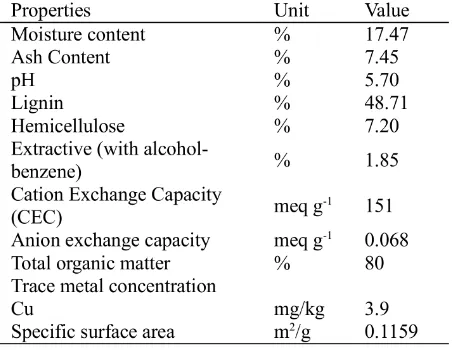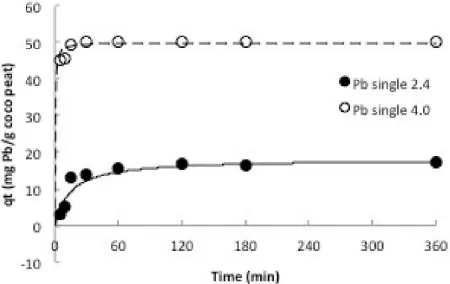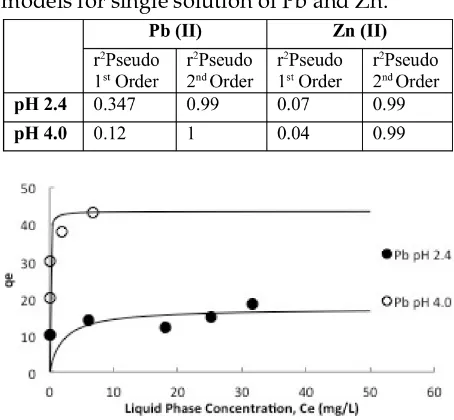KINETIC AND EQUILIBRIUM STUDIES ON THE
ADSORPTION OF Pb
2
+
AND Zn
2
+
FROM
AQUEOUS SOLUTION USING COCO-PEAT BY
BATCH EXPERIMENT
Kukuh Jalu Waskita∗1, Augustus C. Resurreccion2, and Wawan Budianta3
1Environmental Engineering, Graduate Program, University of the Philippines, Diliman, Quezon City, Philippines 2Institute of Civil Engineering, University of the Philippines, Diliman, Quezon City, Philippines
3Department of Geological Engineering, Faculty of Engineering, Gadjah Mada University
Abstract
The presence of heavy metals in surface water, which is common in mining area pose harmful effect to hu-man health and the environment. Recently, coco-peat has been studied as an effective sorbent mate-rial for removing heavy metals from wastewater. In this study, kinetic was done by analyzing the dis-tribution of the heavy metal in sorbent material and liquid phase after mixing 50 mg/L solution of lead (Pb2+) and zinc (Zn2+)in single solute system with 0.1 g of coco-peat, that were consequently shaken at 5, 10, 15, 30, 60, 120, 180 and 360 minutes. To determine the equilibrium adsorption isotherm for each heavy metal, the solutions of 10, 20, 30,40 and 50 mg/L of Pb2+and Zn2+ were prepared sep-arately. Two different pH levels (natural pH, and pH 4) were setto describe the sorption behavior of Pb2+and Zn2+of each heavy metal.Using data from batch experiments, appropriate kinetic (time depen-dency) and equilibrium (isotherm) models were fit-ted on the sorbent material and liquid phase concen-trations to determine adsorption parameters. Pseudo second-order kinetic model fitted well to the kinetic data due to chemisorption that happened during ex-periments.In other hand, Langmuir model fitted well to the equilibrium, this indicates that the sorption of lead and zinc on coco peat is monolayer and that the adsorbent’s surface is homogenous. The increase of
∗Corresponding author: K.J. WASKITA,
Environmen-tal Engineering, Graduate Program, University of the Philippines, Diliman, Quezon City, Philippines
heavy metals adsorption following the increase of pH might be due to negative charge of coco peat surface. Pb2+ adsorbed more than Zn2+ because ion with high hydration enthalpy will have smaller amount of ion adsorbed. The hydration enthalpies for Pb2+and Zn2+ are 23 kJ/kg and 113 kJ/kg, receptively. Con-sidering all the factors that we have discussed, coco-peat has high efficiency to remove the heavy metals from wastewater.
Keywords: Coco-peat, adsorption, batch experi-ment, kinetic, equilibrium.
1 Introduction
Nowadays, removal of heavy metals us-ing bio-sorption materials were investigated in many researches due to low cost, abun-dantly available in tropic countries as agri-cultural waste and renewable (Macedo et al, 2006). One of the effective sorbents within heavy metalremoval is coco-peat. Researches have been doneusing coco-peat from coconut husks as a sorbentmaterial to quantify the ef-ficiency of removal heavymetals that are com-mon in wastewater such as Lead (Pb2+) and Zinc (Zn2+) using batch and/or column stud-ies.Adsorption studies have shown that coco-peat can effectively bindlead and zinc ions (Conrad and Hansen, 2007; Ong, 2010; Quek, 1998). However, these studies have not inves-tigated theparameters such as the increasing of pH.
Sorptionis a major process influencing the transport of pollutants in soils (Clark, 1996). Sorption can be further categorized into ad-sorption, abad-sorption, ion exchange, diffusion and precipitation. These types of sorption have different processes and characterizations. Ad-sorption is the process whereby solutes bind to surfaces of soil particles to form outer or innerspheresolute-surface site complexes (Se-limet al, 1990) and absorption is the process of a solute compound attaching itself or chemically bond within a soil particle (Loll and Moldrup, 2000).
Ion exchange is the process whereby charged solutes replace ions on soil particles (Selim et al, 1990). This study investigated the use of natural coco-peaton heavy metals removal in a synthetic wastewater by adsorption through batch experiment set up. The different solu-tions were prepared to highlight the effect of ion competition on equilibrium and kinetic studies. In addition, the effect of pH on the adsorption of Pband Zn as single species and when both species are present is further considered. Pre-vious adsorption studies have shown it to have good metal binding ability (Macedoet al, 2006; Parcon, 2010).
Studying the effects of metal ion competi-tion on equilibrium and kinetic studies yields results that are valuable for future adsorption
Table 1: Physical and chemical characteristics of coco-peat for this research (Parcon, 2010).
researches and in the design of adsorbent sys-tems.
2 Materials and Methods
2.1 Sample preparation
Coco-peat was taken from Soriano Integrated Fiber Corporation located in Sariaya, Quezon City, Philippines. The samples were taken from the top of a fresh mound of peat. The coco-peat was passed through sieve no. 10 in order to eliminate the larger particles and impurities, and then stored in a cool and dry place. Table 1 shows the physic-chemical characteristics of the cocopeat used in this study.
Pb(NO3)2 and Zn(NO3)2 standard solutions
were used as stock solutions. Solutions with different concentrations were prepared by di-luting the stock solution with deionized wa-ter. In order to adjust the pH of heavy metals solutions, 0.1 M of HNO3 and or NaOH were
added.
2.2 Batch adsorption studies
an-alyzed for metal concentration using a Flame Atomic Absorption Spectrophotometer (AAS).
2.3 Kinetic studies
Using an initial metal concentration of 50 ppm and initial natural pH and adjusted pH of 2,4 and 4, batch experiments were performed using the following contact times: 5 minutes, 10 min-utes, 15 minmin-utes, 30 minmin-utes, 60 minmin-utes, 120 minutes, 180 minutes and 360 minutes.
The amount of solute adsorbed per unit weight of sorbent at any timet,qt(expressed in mg metal/g coco-peat), is computed using the following equation.
qt= (Co−Ct)V
W (1)
whereCo is the initial metal concentration in mg/L;Ct is the measured metal concentration at timetexpressed in mg/L;Vis the volume of metal solution used in L; andWis the weight of adsorbent in grams.
Kinetic models
In order to investigate the mechanism of sorp-tion and potential rate controlling steps such as mass transport and chemical reaction processes, kinetic models have been used to test experi-mental data. The kinetic models used in this experiment are the pseudo-first order kinetic equation and the pseudo second order equation (Ho and McKay, 1998).
The pseudo-first order kinetic model pro-posed by Lagergren (1898) is expressed as fol-lows:
dqt
dt = k1(qe−qt) (2)
where, qt and qe are the sorption capacity (amount adsorbed) at equilibrium time and at any time t, respectively; expressed in mg of metal per gram of coco-peat; k1 is the kinetic
rate constant expressed in min−1.
After integration and applying boundary conditionsqt=0 andt=0 andqt =qtatt= t, the equation can be expressed in linearized form of the pseudo-first order kinetic equation:
log(qe−qt) =logqe− k1
2.303 (3) Aplot of log (qe−qt)versust should yield a straight line from which k1 andqe can be
esti-mated.
Many studies on adsorption have kinetic data that fitted well with the pseudo-second order kinetic model. This model is based on the as-sumption that the rate-limiting step may be chemical sorption or chemisorption which in-volves valency forces through sharing or ex-change of electrons between sorbate and sor-bent.
The pseudo-second order chemisorptions ki-netic rate equation is expressed as:
dqt
dt = k2(qe−qt)
2
(4)
where, qt and qe are the sorption capacity (amount adsorbed) at equilibrium and at time t, respectively, expressed in mg of metal per grams of coco-peat andk2is the kinetic rate
con-stant expressed in min−1for pseudo-second or-der sorption.
After a process of integrating the original equation, the following is now the linearized form:
versus t yields a linear relationship, the slope and intercept of which can be used to compute forhandqe.
2.4 Equilibrium studies
Adsorption isotherm models
The adsorption isotherms were obtained from the equilibrium data. The change in the con-centration of solute at the interface when so-lute concentration is increased is known as an isotherm (Clark, 1996). In terms of the adsorp-tion of metal in aqueous soluadsorp-tions, an isotherm shows the amount of metal adsorbed by the adsorbent as the concentration of the metal in the solution is increased. Freundlich and Lang-muir isotherms are the the simplest known re-lationships describing the adsorption equation. These two isotherm models were used to as-sess the different isotherms and their ability to correlate the experimental data (Igwe and Abia, 2007).
The Langmuir isotherm model is based on a kinetic principle, which is the rate of adsorp-tion at the surfaceis equal to the rate of desorp-tion from it. This model is applicable for mono-layer adsorption. It is used to obtain a max-imum adsorption capacity based on complete monolayer coverage of adsorbent surface [11]. This model is the most basic isotherm model and assumes that surface is homogeneous. The isotherm equation is represented as:
qe
Qm =
bCe
1+bCe (6)
where b is the adsorption equilibrium con-stant (in L mg−1) and is related to the
appar-ent energy of adsorption; Qm is the monolayer adsorbent capacity, described as the quantity of adsorbate required to form a single mono-layer on a unit mass of adsorbent and is ex-pressed in mg g−1; qeis the amount of compo-nent adsorbed on the adsorbent (mg g−1) when
the concentration of that component in the so-lution at equilibrium isCe (mg L−1). Equation (6) can be rearranged to obtain the linear form, expressed as:
a plotCe/qeversusCeshould yield a straight line if the adsorption process follows Lang-muir’s theory. The Freundlich isotherm was derived empirically for solid-liquid systems (Clark, 1996). The model describes that the
Figure 1: Adsorption behavior of lead (Pb2+) over time at different pH.
ratio of the amount of solute adsorbed to a cer-tain mass of adsorbent to the concentration of solute in the solution is not constant at different concentrations (Gupta and Babu, 2009). It is given by the equation:
qe=KfC1/e n (8)
whereKf is an empirical constant associated to the capacity of the adsorbent to adsorb the adsorbate and is expressed in (mg g−1)(L mg−1
)1/n. The higher the value ofKf, the more ad-sorbate is potentially sorbed;nis the Freundlich constant and describes the deviation of the ad-sorption from linearity. qeandCehas the same connotation as that in Langmuir isotherm. The coefficients can be obtained by plotting the lin-ear form of the model:
logqe =logKf + 1
nlogCe (9)
3 Results
The adsorption of metal ions is affected by the contact time between the sorbate and the sor-bent. Hence the sorption of all metal ions onto coco peat was studied as a function of contact time from 5 minutes to 360 minutes. The effect of pH was also observed to the amount of heavy metals absorbed. The results are illustrated in Figures 1–2.
Figure 2: Adsorption behavior of zinc (Zn2+) over time at different pH.
increase for the first 30 minutes and followed by a constant value beyond 60 minutes. Thus, the 60 min equilibrium time was employed for the equilibrium time for experiments. Another study has observed the same equilibrium pe-riod of 1 hour using unground coir for the same heavy metals (Conrad and Hansen, 2007). The highest equilibrium adsorption capacity, qe for lead was obtained at pH 4.0 with 100% removal or 50 mg/g cocopeat of Pb2+removed.
The sorption of Zn2+ as shown in Figure 2 followed the same trend of increasing sorption with increasing contact time except the zinc so-lutions at pH 2.4. The 60 min equilibrium time is also used for further experiments for zinc in single and binary solute system. It can be ob-served that qe, the amount of metal ions ad-sorbed at equilibrium time, increased as the pH is increased for all systems. Experimental re-sults have shown that Pb was fully removed at pH 4.0. Zinc, however, was only removed at 7.292 mg/g at pH 4.0.
3.1 Kinetic studies
Experiments on sorption kinetics are important to determine the type of sorption between a heavy metal and its sorbent. The pseudo first order kinetic model, assumes the rate of uptake is limited to one mechanism that is acting on a single class of sorbing sites. The pseudo second order kinetic model states that the rate-limiting step of reaction involves an exchange or shar-ing of electrons between the heavy metal and
Table 2: Correlation coefficients (r2) for pseudo
first order and pseudo second order kinetic models for single solution of Pb and Zn.
Figure 3: Fitted Adsorption Isotherm Model (Langmuir) of Lead at different pH.
sorbent – the process is also called chemisorp-tion (Ho and McKay, 1998).
However, when the data was fitted to the pseudo first order kinetic model, the correla-tion is poor to describe the sorpcorrela-tion behavior between the given heavy metals and coco-peat for this experiment. It is more likely that the experiment data well suited for the pseudo sec-ond order kinetic model as shown in Table 2.
Ther2values for pseudo-second order kinetic model are close to unity indicating that the rate-limiting step in the adsorption of lead and zinc on coco-peat is chemisorption.
3.2 Equilibrium studies
Figure 4: Fitted Adsorption Isotherm Model (Langmuir) of Zinc at different pH.
Table 3: Correlation coefficients (r2) for Lang-muir and Freundlich isotherm models.
4 Conclusions
Based on the results of this study, the following conclusions are drawn:
• The kinetic data fitted were satisfactory to the pseudo second order kinetic model. The rate of uptake of the heavy metals in coco-peat is described as chemisorption.
• The effect of an increase in pH in the kinet-ics, as well as in the isotherms, is evident and showed an increase in the Sorption Ca-pacity of coco-peat.
• The Langmuir isotherm fits better in Pb2+, therefore the sorption between the heavy metal and coco-peat is of monolayer cov-erage.
• The amount of Pb (II) adsorbed in coco-peat was greater in comparison to Zn (II) adsorbed because higher hydration en-thalpy will have smaller amount of ion adsorbed. The hydration enthalpies for Pb2+and Zn2+are 23 kJ/kg and 113 kJ/kg, respectively.
Acknowledgements
The authors wish to thank the following: JICA Project for AUN/SEED-Net for funding this research, Soriano Integrated Fiber Corpora-tion for providing the coco-peat, and Anfy M. Cubunilas and Jessabel R. Riginio were helping finish the experiment.
References
Clark, M.M. (1996) Transport modeling for environ-mental engineers and scientists. John Wiley and Sons, Inc., Canada.
Conrad, K. and Hansen, H.C.B. (2007) Sorption of Zinc and Lead on Coir, Bioresource Technology 98: 89–97.
Gupta, S. and Babu, B.V. (2009) Removal of toxic metal Cr (VI) from aqueous solutions using saw-dust as adsorbent: Equilibrium, kinetics and re-generation studies. Chemical Engineering Jour-nal 150: 352–365.
Ho. Y.S., and McKay. G. (1998) A Comparison of chemisorptions kinetic models applied to pollu-tant removal on various sorbents. Institution of Chemical Engineer 76 Part B. Solution on Coco-peat.
Igwe, A. and Abia, A. (2007) Equilibrium sorption isotherm studies of Cd(II), Pb(II) and Zn(II) ions detoxification from waste water using unmodi-fied and EDTA-modiunmodi-fied maize husk.? Electronic Journal of Biotechnology, 10(4).
Loll, P. and Moldrup, P. (2000) Soil characterization and polluted soil assessment. M.Sc. Course, Aal-borg University, Chapter 5, page 75–95
Macedo, J.dS, Junior, N.B.dC., Almeida, L.E., Viera, E.F.dS., Cestari, A.R., Gimenex, I.dF., Careno, N.L.V., and Baretto, L.S. (2006) Kinetic and Calori-metric study of the adsorption of dyes on meso-porous activated carbon prepared from coconut coir dust. Journal of Coloid and Interface Science 298: 512–522.
Ong, D.C. (2010) Removal of Heavy Metals from single species and composite species aqueous solutions using coco peat as sorbent material. M.S. Thesis, University of The Philippines, Dili-man,Quezon City, 2010.
Parcon, M.R.R. (2010) Equilibrium and Kinetic Stud-ies on the Adsorption Lead and Copper in Aque-ous Solution on Coco peat. M.S. Thesis, Univer-sity of the Philippines, Diliman, Quezon City. Quek, S.Y., Al-duri, B., Wase, D.A.J., and Foster, C.F.
Selim, H.M., Amacher, M.C., and Iskandar, K.X. (1990) Modeling the Transport of Heavy Metals in Soils. Monograph No. 90-2, American Society



